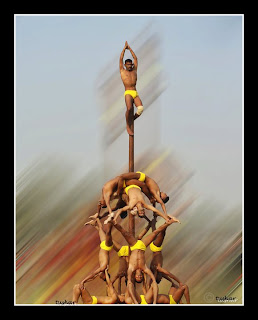The earliest recorded references to Mallakhamb is found in the 12th century classic Manasollasa (1135 AD) by Somesvara Chalukya.
 |
| PHOTO BY ME |
Types of mallakhamb
Originally mallakhamb was introduced as a supporting exercise for wrestlers. "Pole mallakhamb" was started by Balambhattdada Deodhar sometime between 1800 and 1810. Later on, his student Damodarguru Moghe realized that only major grips can be developed with a pole and used cane instead of a pole. Subsequently, the unavailability of cane resulted in rope mallakhamb. Almost 25 to 30 types of mallakhamb apparatus were tried and tested over the years.
Competitively there are three main variations of mallakhamb.
Pole or fixed mallakhamb
In this variation, a vertical wooden pole is fixed in the ground and the participant performs various acrobatic feats and poses while hanging on the pole.The mallakhamb pole used in competitions is a straight pole made of teak or sheesham wood, standing 2.6 metres (8.5 ft) in height with a circumference of 55 centimetres (22 in) at the base. It gradually tapers to a circumference of 35 centimetres (14 in) at the top.
 |
| PHOTO BY ME |
 |
| PHOTO BY ME |
Hanging mallakhamb
Similar to the pole mallakhamb, the hanging mallakhamb is a wooden pole that is shorter in length than the standard Pole Mallakhamb and is hung from chain and hooks, leaving a gap between the ground and the bottom of the mallakhamb.Rope mallakhamb
In this variation, the participant performs exercises while hanging from a rope suspended from a support.SOURCE:-WIKIPEDIA
No comments:
Post a Comment